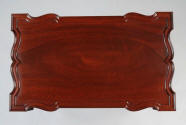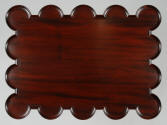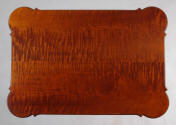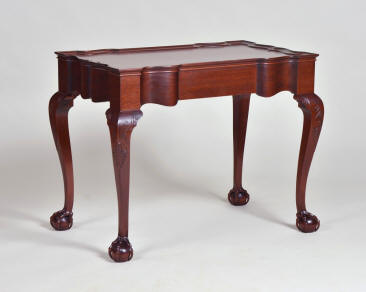
mahogany, 27"h, 33"w, 19½"d
One of
the most spectacular examples of 18th-century Newport cabinetmaking is a
tea table from the John Goddard shop in its fully developed form, replicated here in
exacting detail. This example has overcut, open-talon ball and
claw feet and knees carved in the Goddard pattern. The top conforms to
the sculpted shape of the apron and is one piece dished from the solid.
The table frame is of
mortise-and-tenon construction with concealed leg blocks. The top is let
into the frame and secured with cleats, as was the original, allowing
for seasonal movement.
The original was made by the Goddard shop
for Nicholas Brown and it descended in the family until its sale in
January 2005 for in excess of $8 million.
similar example: Sotheby's 8055, January 2005
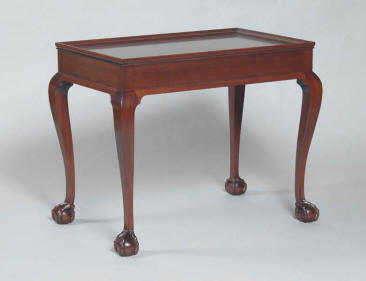
mahogany, 26½"h, 32½"w, 20½"d
Rectangular tea tables with cabriole legs and an applied top molding were favored in 18th-century Newport. This example is in the manner of the Goddard family shop with four Goddard-style open-talon, overcut ball and claw feet, identical to the previous table. A radiused molding spans the bottom edge of the apron, visually connecting the legs. The one-board top is framed by an applied ogee top molding.
The construction is mortise and tenon with the top let into the frame. The top is affixed by the top molding in such a way as to allow for seasonal movement.
similar example: Monkhouse & Mitchie p. 133
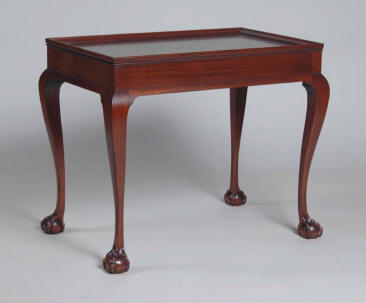
mahogany, 27"h, 33"w, 21"d
A ball and claw foot version of the more common slipper-foot tea table, after an early John Townsend original. Townsend's early style of foot carving appears on only a handful of pieces. His early feet are detailed and precise without the tall, stylized appearance of his later work. The four feet have slender digits, rounded knuckles, and open talons. The one-board top is surrounded by an applied ogee molding.
The construction is of mortise-and-tenon joinery and the top is let into the frame. The ogee molding secures the top while allowing seasonal movement.
similar example: Monkhouse & Michie p.133
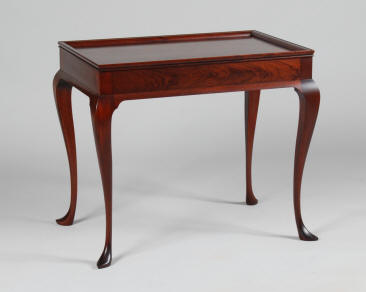
mahogany, 27"h, 32"w, 21"d available
The classic Newport rectangular tea table of timeless grace and simplicity. This slipper-foot design is in the manner of Christopher or early John Townsend, as exemplified by the strong sweep of the leg, and is an exacting replica of an original. The apron is narrow, lending lift and lightness to the design. The one-board top is surrounded by a radiused top molding with edge bead.
The construction is mortise and tenon and the top is let into the frame. The applied top molding holds the top and allows for seasonal movement.
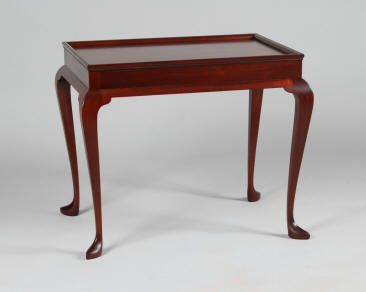
mahogany, 26"h, 31½"w, 20½"d
The original of this slipper-foot tea table was given to the Newport Historical Society by Miss Ellen Townsend (granddaughter of John and great-granddaughter of Christopher) in 1884. Curiously, it doesn't seem to have been made by either of them, and is more likely the product of Job Townsend's shop (Christopher's brother). The original is on display at NHS's Museum of Newport History on Washington Square and is replicated under an agreement with the Society. It's a charming table with a subtle curve to the legs and strong slipper feet.
The table is seen in Miss Ellen Townsend's parlor in this watercolor by Mary Buffum c. 1880 (courtesy of Newport Historical Society):
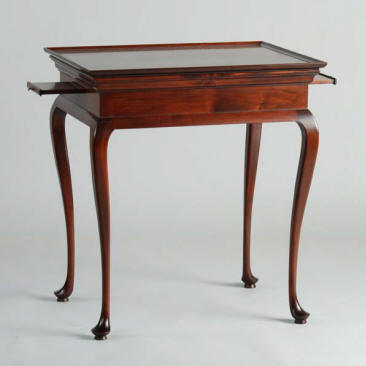
walnut, 27"h, 24½"w, 18"d
A number of unique designs were made in 18th-century Connecticut, among them this diminutive tea table that descended in a Suffield family. It is remarkable for its slender and graceful legs that end in pad feet on flared disks. The top is crotch-grained walnut that has been bookmatched to enhance the pattern. The top is dished from the solid to create the tray edge. Below the top, a bold ogee molding completes the transition between the frame and top. Candle slides extend from either side.
similar example: Sack vol. X, p.2576
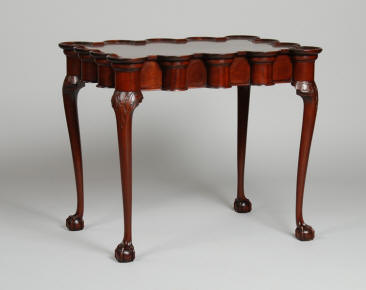
mahogany, 27½"h, 30"w, 19½"d
A small group of 12 and 14-turret tea tables were made in Philadelphia and Boston. Their riveting appearance is best describe as one of "constrained energy". This is a 14-turret table from Philadelphia with four compact Philadelphia ball and claw feet and Rococo foliate carving on the knees. The top is dished from the solid and follows the intricate pattern of the corner and side turrets.
The top is secured to the underlying rectangular table frame in a manner that allows the for the seasonal movement of the mahogany.
ref. Sack Vol. X, p. 64
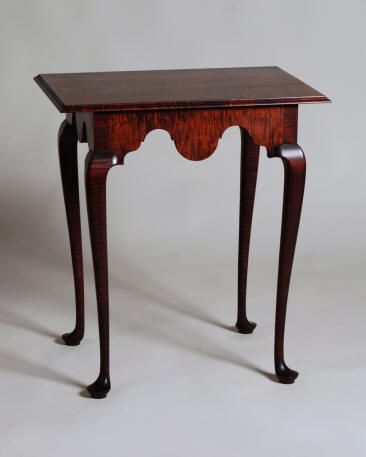
figured maple, 28½"h, 26"w, 18"d
A diminutive Boston Queen Anne tea table with boldly shaped aprons and long, graceful cabriole legs ending in pad feet. The overhanging top features a molded edge. The table has a great amount of lift, in keeping with the design ideals of its day.
Originally walnut, but equally striking in mahogany, figured maple, or cherry. The pegs are visible in the mortise-and-tenon frame joinery.
similar example: Fairbanks & Bates p. 124
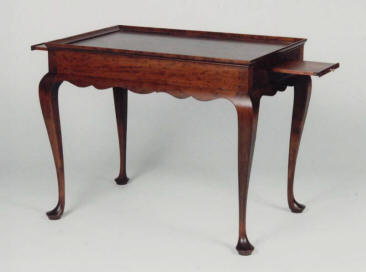
cherry, 25½"h, 32"w, 20"d
A scalloped-apron tea table in the Massachusetts tradition. The scalloped apron design blends into the cabriole legs, which end in pad feet. The top has an applied cove-molded tray edge. In addition, the table has generously-sized slides that extend from either end for candles or to increase serving space.
This is shown in cherry, but it is also available in mahogany or figured maple.
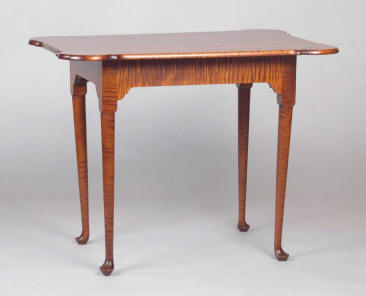
figured maple, 27"h, 34½"w, 24"d available
Sometimes referred to as a "common tea table" in early inventories, tea tables with turned and tapered legs were less expensive than their cabriole-legged counterparts. The porringer top was a Rhode Island favorite. The table top has a slightly rounded, beveled edge that shows the porringer shape well.
Shown in figured (tiger) maple, but also available in mahogany, walnut, and cherry. The inset shows the top detail.
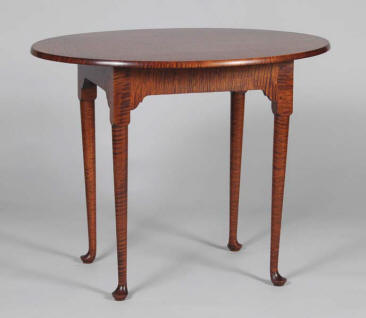
figured maple, 27"h, 34"w, 25"d available
The oval tea table was a design in widespread use throughout New England in the 18th century. Nicely proportioned, it has turned and tapered legs with a rounded, beveled table top edge.
Shown in figured (tiger) maple, but also available in cherry, walnut, and mahogany.
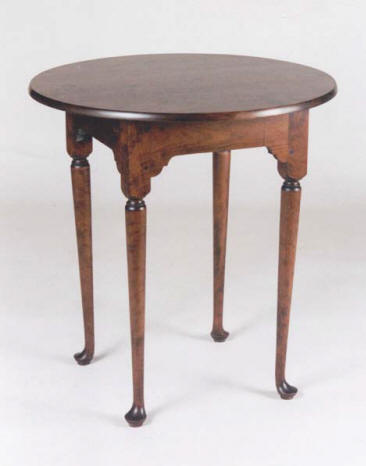
cherry, 27"h, 25w, 25"d
An rare circular tea table design with details similar to other "common tea tables". This has turned and tapered legs ending in pad feet with decorative turned leg details just below the apron. The top has a slightly rounded beveled edge that finishes the design handsomely.
Shown in cherry, but also available in figured or tiger maple, walnut, or mahogany.
similar example: Nutting 1259

